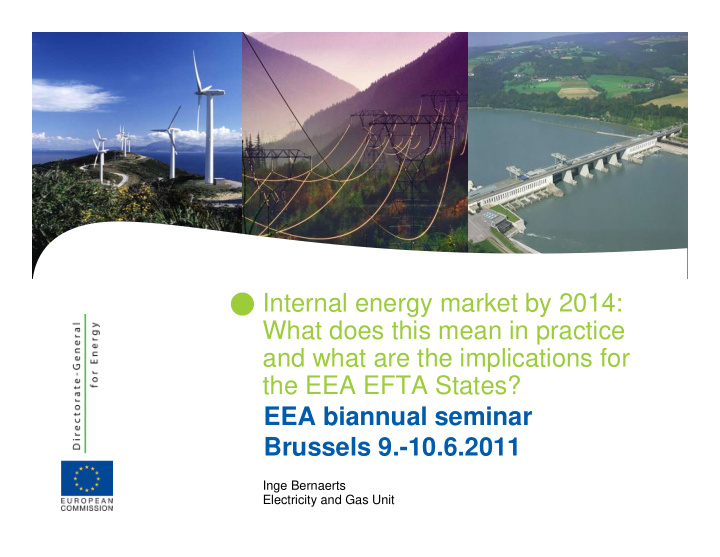



� Internal energy market by 2014: What does this mean in practice and what are the implications for the EEA EFTA States? EEA biannual seminar Brussels 9.-10.6.2011 Inge Bernaerts Electricity and Gas Unit
� Drivers of the EU internal energy market policy . Reduce costs for businesses and households – . Diversify sources of supply (energy mix + external gas cushion global energy price rises . Integrate renewables in a cost-efficient way supplies) Affordable energy Secure energy supplies Sustainable use of resources | EEA biannual seminar 9.-10.6.2011 2
� Estimated effects of opening EU gas & electricity markets (ranges) 1,0% 0,8% Effect on GDP 0,6% 0,4% Effect on Employment 0,2% 0,0% -0,2% -0,4% Effect on Inflation -0,6% -0,8% After 1 Year After 5 Years After 10 Years Achieving a fully functioning and competitive European electricity and gas market can add an extra 0.6% - 0.8% to EU GDP by 2020, create employment and curtail inflation. | EEA biannual seminar 9.-10.6.2011 3
� February 2011 European Council . ”The internal market should be completed by conclusions 2014 so as to allow gas and electricity to flow freely” » Implementation of adopted legislation » Development of infrastructure » Harmonization of market design through the adoption of guidelines and network codes | EEA biannual seminar 9.-10.6.2011 4
� 3rd package Directives: main novelties . Effective unbundling of transmission system . Cooperation of transmission system operators operators . Strict independence rules and stronger (ENTSOs) . ACER powers for national regulators . Stronger consumer protection | EEA biannual seminar 9.-10.6.2011 5
� Implementation – state of play . Transposition date: 3 March 2011 . No Member State has notified complete set of . But good upstream cooperation between transposition measures yet national administration and Commission . ACER and ENTSOs up and running services to ensure correct transposition . Development of guidelines and network codes is well in progress | EEA biannual seminar 9.-10.6.2011 6
� ACER . Budget & Staff: » About 40-50 people » Annual budget around €6-7 million » ACER resources will depend on work and . Seat: know-how contributions from NRAs » Ljubljana | EEA biannual seminar 9.-10.6.2011 7
� Ongoing work on guidelines and network codes - electricity . Electricity: » Grid connection (ACER framework guideline by July) » Capacity allocation and congestion management (idem) » System operation (FG by end 2011) » Balancing (FG in Q1 2012) » Governance (EC comitology guideline by end 2011) » Transparency (EC comitology guideline by end 2011) | EEA biannual seminar 9.-10.6.2011 8
� Ongoing work on guidelines and network codes - gas . Gas: » Capacity allocation (ACER FG in July – ENTSOG consultation on pilot code in June) » EC comitology guideline on congestion management (end 2011) » Balancing (ACER FG in July) » Interoperability (ACER FG by end 2011) | EEA biannual seminar 9.-10.6.2011 9
� Network codes | EEA biannual seminar 9.-10.6.2011 10
� EEA and EFTA . Norway: we expect full alignment with EU rules . Iceland: potential EU member, energy matters will be » For gas, Norway is an emerging market . Switzerland: negotiations ongoing for full integration discussed in accession negotiations into EU electricity market . Lichtenstein: no ongoing negotiations on energy » too early to see the possible outcome yet . Participation of non-EU countries in ACER and ENTSOs: subject to third package rules (or equivalent) being applicable and enforced | EEA biannual seminar 9.-10.6.2011 11
� Conclusions . EEA and EFTA countries are important . EU wishes a full integration of EEA and EFTA partners of EU regarding energy countries in the internal electricity and gas . Meeting Council 2014 target is realistic but markets . Third package provides for the necessary needs hard work institutional framework and tools | EEA biannual seminar 9.-10.6.2011 12
� Thank you for your attention | EEA biannual seminar 9.-10.6.2011 13
Recommend
More recommend